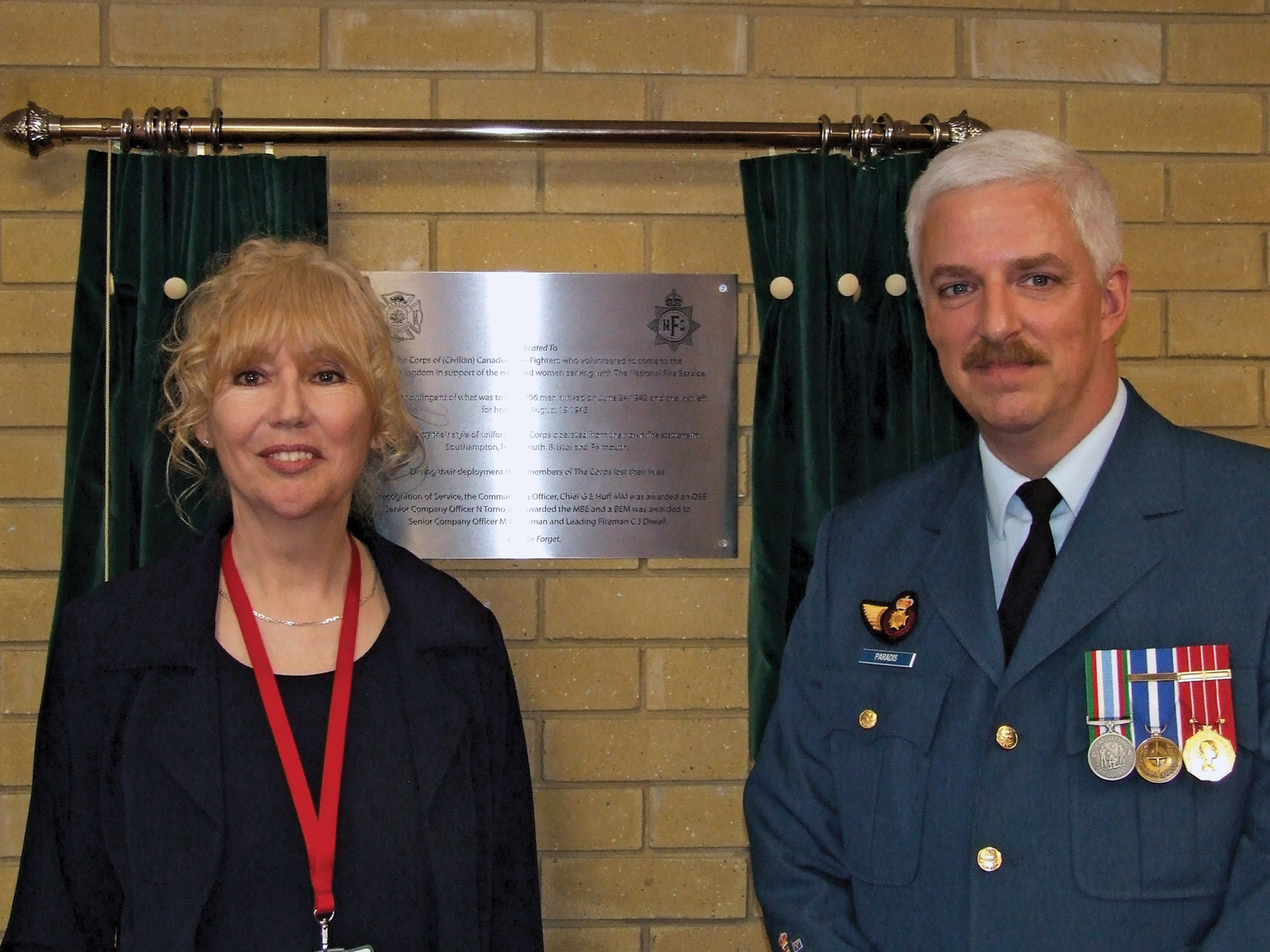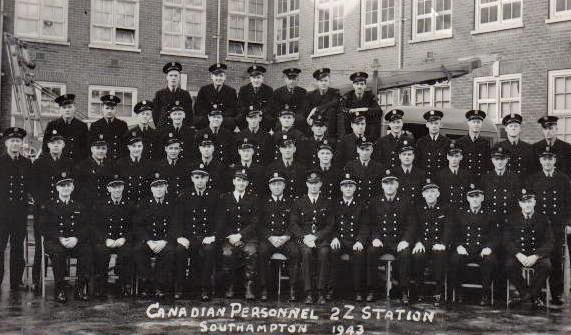Canadian firefighters helped England fight fires
By Lookout on Nov 18, 2020 with Comments 0

Elaine Bryce, daughter of Gordon Bryce, a member of the Corps of Canadian Firefighters, with CWO Bruce Paradis at the plaque unveiling to honour the Corps.
Peter Mallett
Staff Writer
––
If you visit the headquarters of Hampshire Fire and Rescue Service in southern England you will notice a commemorative plaque mounted in its entranceway.
The flat tablet of brass is prominently displayed next to a portrait of Her Majesty Queen Elizabeth II. Upon closer inspection, a casual observer will quickly understand it serves to honour the bravery and valour of the 422 members of the Corps of Canadian Fire Fighters, who volunteered for service in the paramilitary organization to help during Germany’s infamous Blitz on England in the early 1940s.
Canadians filled the ranks of National Fire Service and deployed across London, Southampton, Portsmouth, Bristol and Plymouth to fight the fires.
The monument also serves as a memorial to three Canadian firefighters who died during their service. Three others were seriously injured in the line duty.
The dedication ceremony
In February 2008, Chief Warrant Officer (now retired) Bruce Paradis led a Canadian delegation to the dedication ceremony. He served in the Canadian Forces National Defence Fire Service for 36 years and currently volunteers as the Treasurer of the Canadian Fallen Firefighters Foundation and as its Atlantic Canada Director.
“The Corps was an unknown because they did not fight as soldiers, but they served and served well. These brave Canadians worked alongside their British counterparts who had been devastated by the constant fires cause by the dreaded V1 buzz bomb,” he said.
The unveiling ceremony in Hampton also served as a book launch for local author John Leete, who worked with the Hampton Fire and Rescue Service. His book Under Fire chronicles the formation of England’s Auxiliary Fire Service in the late 1930s and eventually the emergency provisions made for a National Fire Service in 1941. He devotes two chapters to the role of Canadian firefighters who served England with distinction between 1942 and 1945.
A Cry For Help
The devastation from German bombings in London was immense. According to the Canadian Firefighters Museum, during a 60-day period starting September 1940, Germans pounded England with rocket attacks and caused no fewer than 17,714 structure fires in London proper. But the bombings encompassed a much larger area than just London, and included much of southern England and areas as far north as Manchester.
It wasn’t until the summer of 1941 that the call for Canadian volunteers went out. That was precipitated by Canadian Prime Minister William Lyon Mackenzie King’s visit to London in the summer of 1941. It was then that the Prime Minister saw with his own eyes the level of destruction that had occurred, says Paradis.
The number of air attacks by the Germans had greatly reduced by early 1942, but England was still under bombardment. The first Canadian contingent of firefighters arrived in June 1942 and by December all 422 personnel were in place serving the southern area of the country in London, Southampton, Portsmouth, Bristol, and Plymouth.
“From the mouth of the Prime Minister of Canada to the deployment in the UK, it is remarkable that it took only six months to call for volunteers from our existing Canadian departments and have just over 400 men on the ground in the U.K.,” says Paradis.
Their job, upon the sounding of the air raid sirens, was to leave their quarters and proceed into the deserted streets while the populace took shelter.
“This allowed them to be tactically deployed in the event that a lucky bomb found their home station, and allowed them to spot fires caused by the bombings,” he says.
They worked in perilous conditions conducting search and rescue operations and extinguishing or controlling fires started by the bombings. The Corps was commanded by Gordon E. Huff, a former Fire Chief of the Brantford, ON, Fire Department.
Before they could return to Canada in late 1944, a parade was held in London in their honour, from Trafalgar Square to Canada House. For their efforts, the corps received The Order of the British Empire, British Empire Medals, and the Royal Humane Society Testimonial on Parchment and Vellum along with special badges for individual service.
By the end of the war, 997 firefighters from Canada and England died in their service to the war effort.
––––
Filed Under: Top Stories
About the Author:






